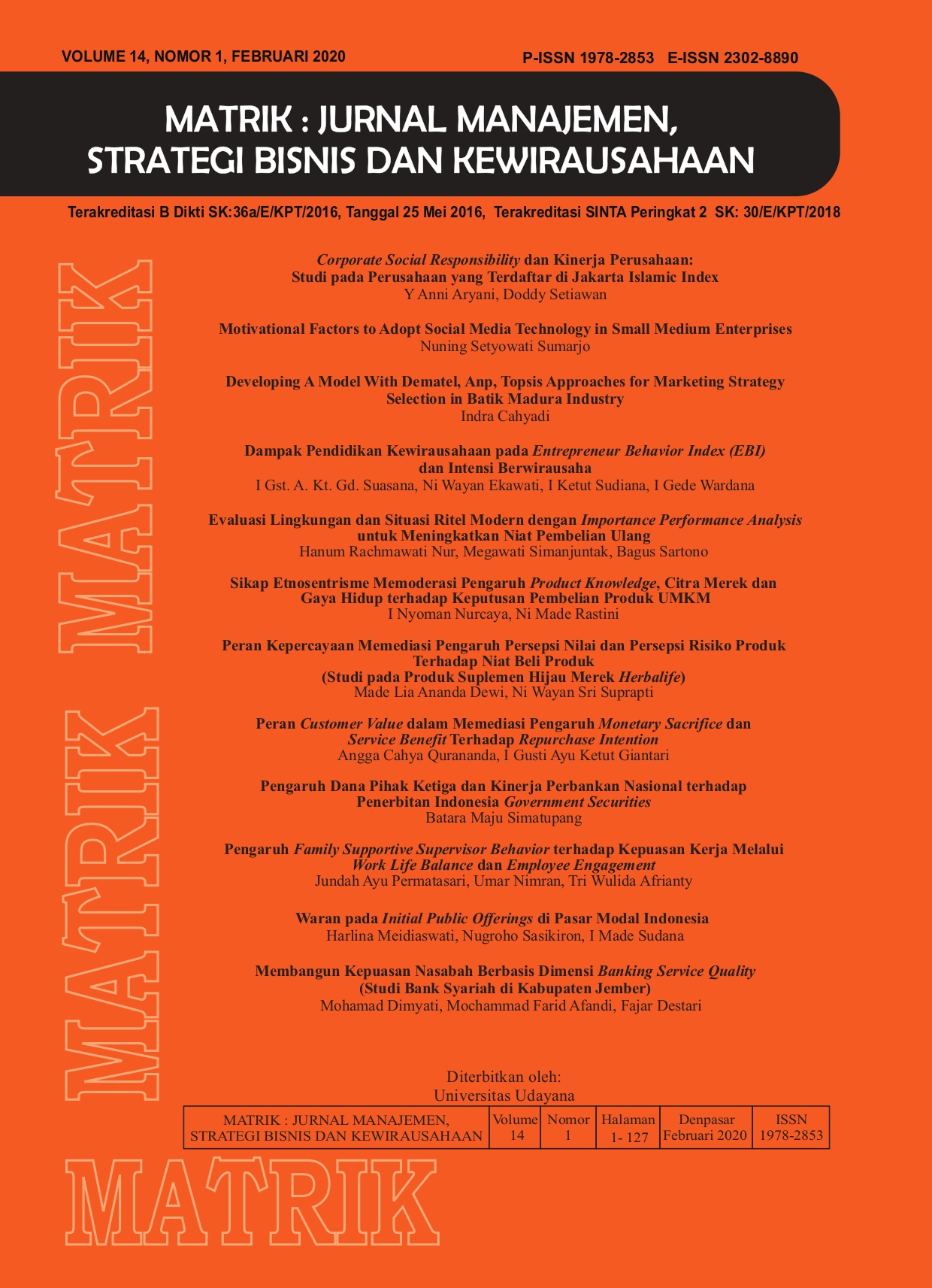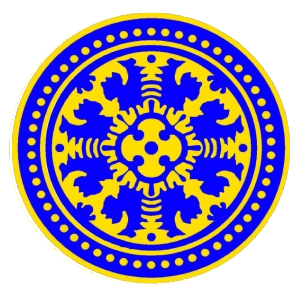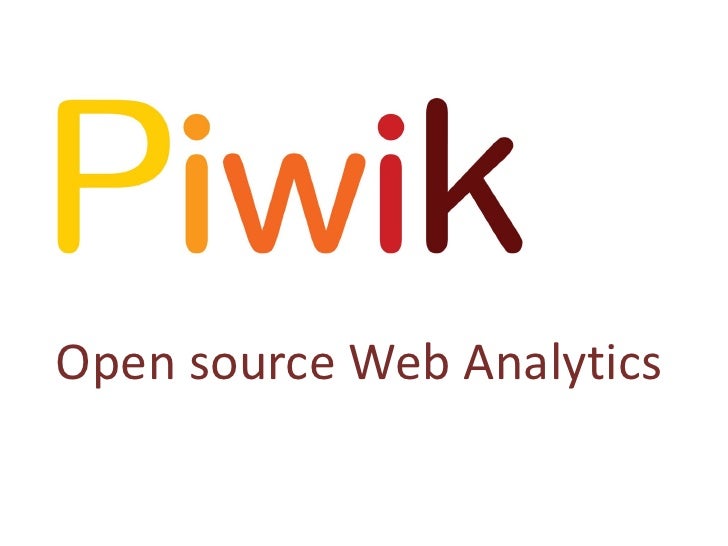Developing A Model with Dematel, Anp, Topsis Approaches for Marketing Strategy Selection in Batik Madura Industry
Abstract
The selection of marketing strategy is very important for the sustainability of small and medium enterprises (SMEs). Choosing the best marketing strategy is a process involving problem of multiple decision-making criteria, which considers many attributes in various phases of a strategy formulation method. This paper proposes a model of selecting marketing strategy for Batik Madura SMEs. The model selected five criteria including customer networking, innovation capabilities, managerial competency, human capital, and company reputation based on literature reviews and focus group decision-making discussion. Analytic network process (ANP), decision-making trial and evaluation laboratory (DEMATEL) and technique for order preference by similarity to an ideal solution (TOPSIS) methods were applied to obtain an impact relation map from each criteria and to determine the priority of marketing strategy. The implementation of the model shows that Batik Madura SMEs should maintain their focus on segmentation marketing as the most appropriate marketing strategy.
Downloads
References
Danis W.M., Chiaburu D.S. and Lyles M.A. 2010. The Impact of Managerial Networking Intensity And Market-based Strategies on Firm Growth during Institutional Upheaval : A Study of Small and Medium-sized Enterprises in a Transition Economy. Journal of International Business Studies, (41) : 287–307.
De Jong J.P.J. and Hulsink W. 2012. Patterns of Innovating Networking in Small Firms. European Journal of Innovation Management, (15) 3 : 280–297.
Ernst H., Wayne D. H. and Carsten R. 2010. Sales, Marketing, and Research-and-Development Cooperation Across New Product Development Stages : Implications for Success. Journal of Marketing, (74) 5: 80-92.
Fontela E. and Gabus A. 1974. DEMATEL : Innovative Methods, Report no. 2, Structural Analysis of the World Problematique. Battelle Geneva Research Institute.
Halim H.A., Ahmad N.H., Ramayah T. and Hanifah H. 2014. The Growth of Innovative Performance
among SMEs : Leveraging on Organisational Culture and Innovative Human Capital. Journal
of Small Business and Entrepreneurship Development, (2) 1: 107-125.
Hooley G.J., Greenley G.E., Cadogan J.W. and
Fahny J. 2005. The Performance Impact of
Marketing Resources. Journal of Business
Research, (58) 1: 18-27.
Hwang C. L. and Yoon K. 1981. Multiple Attribute
Decision Making – Methods and Applications:
A State of the Art Survey, Springer Verlag.
Kazlauskaitë R., Autio E., Gelbûda M. and
Ðarapovas T. 2015. The Resource-based View
and SME Internationalisation : An Emerging
Economy Perspective. Resource, (3) 2.
Lin C.T., Lee C., Wu C.S. 2009. Optimizing a
Marketing Expert Decision Process for the
Private Hot el. Expert Syst ems with
Applications, (36) 3 : 5613–5619.
Lo, W.S., and Hong, T.P. A three-level multiple-agent
early warning mechanism for preventing loss
of customer s in fashion supply chain
management, Industry and Business Analysis,
IGI Global, 2012 pp. 173-184.
Marek P. 2014. A Critical Analysis of the Concept
of Marketing Strategies for Small and Midsized
Companies. Economics : Management
and Financial Markets, (9) 4: 255.
Mohaghar A., Fathi M. R., Sasani A. and Khanmohammadi
E. 2012. Integration of Linear Goal
Programming and Fuzzy VIKOR Method for
Marketing Strategy Selection : A Case Study.
Journal of American Science, (8) 6: 827-834.
O’Cass A. and Ngo L. 2012. Creating Superior Customer
Value for B2B Firms through Supplier Firm
Capabilities. Industrial Marketing Management, (41)
: 125–135.
Saaty T.L. 1996. Decision Making with Dependence
and Feedback : Analytic Network Process.
RWS Publications, Pittsburgh.
Saaty T.L. and Vargas L.G. 1996. Diagnosis with
Dependent Symptoms : Bayes Theorem and
The Analytic Hierarchy Process. Operations
Research, (46) 4 : 491-502.
Sengupta A., Venkatesh D.N. and Sinha A. 2013.
Developing Performance-linked Competency
Model : A Tool for Competitive Advantage.
International Journal of Organizational
Analysis, (21) 4: 504-527.
Soekesi A.E.M. 2013. Karakteristik UKM Batik Pada
Klaster Batik Di Jawa Tengah. Seri Kajian
Ilmiah, (15) 1: 63-70.
Sok P. and O’Cass A. 2011. Achieving Superior
Innovation-based Performance Outcomes in
SMEs through Innovation Resource-Capability
Comp lementarity. Industria l Marketing
Management, (40) 8 : 1285-1293.
Suliyanto, Wulandari S.Z. and Novandari W. 2010.
Competitive Strategy Model for Purbalingga
Batik. Economic Journal of Emerging Markets,
(2) 2 : 169-185.
Van den Bult e C. 2010. Oppor tunities and
Challenges in Studying Customer Networks.
London, Routledge.
Wu C.S., Lin C.T. and Lee C. 2010. Optimal
Marketing Strategy: A Decision-Making with
ANP and TOPSIS. International Journal of
Production Economics, (127) 1 :10190-196.
 This work is licensed under a Creative Commons Attribution-ShareAlike 4.0 International License.
This work is licensed under a Creative Commons Attribution-ShareAlike 4.0 International License.

















